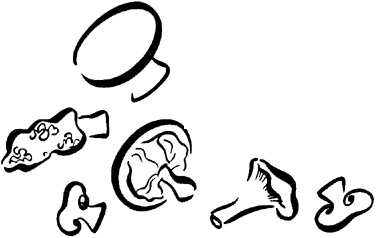
SERVES 4 TO 6
This is a very wild bowlful, at least from the Chinese point of view. Not even a distant cousin of classic fried rice, this is a Western-style mélange of wild rice and wild mushrooms seasoned in a Chinese manner with roasted Szechwan pepper-salt.
The rice is best cooked and left to cool overnight before stir-frying. If you are in a rush, however, a light touch and a nonstick skillet will help get the dish on the table in an hour.

2 cups China Moon Infusion (page 72), Duck Infusion with Szechwan Peppercorns (page 74), Vegetable Infusion (page 82), or unsalted chicken, duck, or vegetable stock
2 to 3 tablespoons home-rendered chicken or duck fat (pages 420 or 170) or corn or peanut oil
⅔ cup thinly sliced leeks
½ cup thinly sliced celery
½ cup diced red bell pepper
1½ cups thinly sliced wild mushrooms
½ cup thinly sliced green and white scallion rings
2½ cups hearts of baby bok choy or baby Chinese celery cabbage, halved lengthwise if fat
2 tablespoons Chinese rice wine or dry sherry
1½ teaspoons kosher salt Roasted Szechwan Pepper-Salt (page 5)

For adding a bit of dash to a bowl of stir-fried something, there’s nothing better than a dab of fresh chicken fat!
Rendering your own is easy. Start with fresh, odor-free chicken skins and the little blobs of fat clinging to them. Accumulate them in your freezer as you skin a breast here and there or trim a whole chicken for dinner.
For a golden fat with a toasty flavor, follow the Western way and put the skins in a heavy, wide pot with enough cold water to cover. Bring to a simmer, then let the mixture bubble along, stirring occasionally, until the water evaporates, the fat turns golden and the skins turn crispy. Don’t let the fat brown; it will taste burnt. Strain the fat through dry cheesecloth or a very fine sieve.
The Chinese method is to simply steam the skins, uncovered, in a bowl. As the fat melts, pour it off into a heatproof container. It’s an undramatic, foolproof method. The fat produced by steaming is pale yellow and very light in flavor.
Home-rendered chicken fat can be kept in the refrigerator or freezer.
1. Rinse the wild rice, following step 1 on page 410.
2. Combine the wild rice and 2 cups infusion in a heavy 2- to 2½-quart pot. Bring to a boil, reduce the heat to a weak simmer, cover tightly, and cook for 20 minutes. Remove to a cool burner and let sit undisturbed for 20 minutes. Half of the grains should be split, and the stock should be absorbed. (If the rice is overly firm and dry, sprinkle with additional stock or water and cook, covered, over low heat until the liquid is absorbed and the rice is pleasantly soft.) Spread the cooked rice thinly on a baking sheet and refrigerate uncovered until thoroughly cold.
3. About 15 minutes before serving, heat a wok or large heavy skillet over moderate heat until a bead of water evaporates on contact. Add the chicken or duck fat, swirl to glaze the pan, and reduce the heat to moderate. When the fat is hot enough to sizzle a slice of leek, add the leeks and toss until supple, about 2 minutes. Add the celery and bell pepper dice, and toss for 1 minute. Add the mushrooms and half of the scallions, and toss for 1½ minutes more. Adjust the heat to maintain a merry sizzle and drizzle a bit more fat down the side of the pan, if needed to prevent sticking.
4. Add the cabbage hearts and toss until they are very hot and the mushrooms begin to render their juices, about 2 minutes more. Add the wine in a necklace around the rim of the pan and toss to blend. Add the wild rice and toss gently to mix. Sprinkle with the salt and toss to heat through. If the rice sticks to the pan, drizzle in a bit more fat. Sprinkle with the pepper-salt to taste and toss to combine.
5. Serve the rice immediately or hold in a covered pot in a low oven for up to 30 minutes. Garnish with the reserved scallion rings.

Back in my Mickey Mouse years, hearts of palm struck me as a romantic vegetable. I’d never seen one (nor have I yet), but I imagined they were eaten by elegant ladies who wore fishnet stockings and elbow-length gloves.
Hearts of baby Chinese cabbages hold something of the same literary lure. These are the 2-inch or so miniature cabbages that reside at the core of the baby vegetable. Chinese artisans traditionally crafted them out of jade, they are so pretty, and they are beautiful in stir-fries. If you can’t find them, use any tiny, fresh green; if substituting something solid, like baby zucchini, blanch them first before adding to the stir-fry.
MENU SUGGESTIONS: A simple roast chicken, duck, or a festive Christmas goose are all set off to advantage by this rice. Ma-La Steamed Poussin with Roasted Szechwan Pepper-Salt (page 153) or Wok-Seared Duck Breasts (page 164) also work well with it.